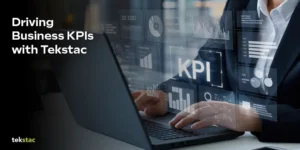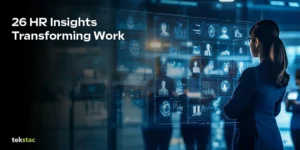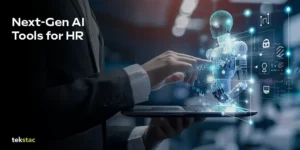The Learning Shift in Action: How Companies Win with L&D Transformation
September 3, 2025
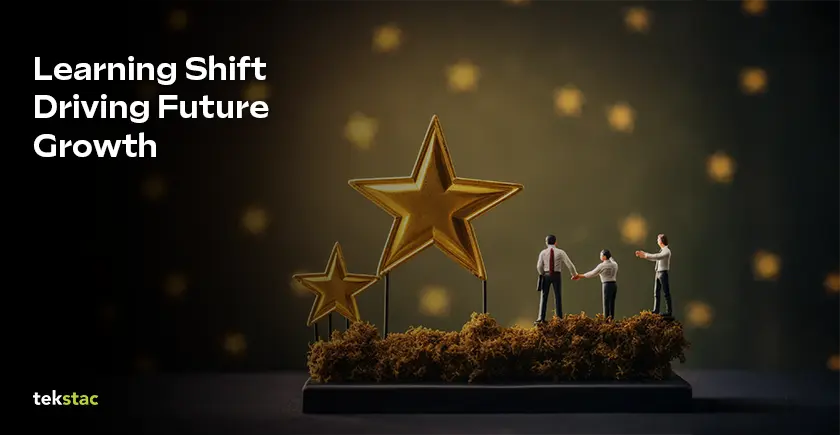
In boardrooms and on the front lines, a quiet revolution is underway.
The world of corporate Learning & Development (L&D), once a predictable function of compliance checklists and scheduled seminars, is undergoing a seismic shift. The old playbook of delivering training for the sake of coverage is being replaced by a far more ambitious mandate: build capability.
It’s less about pushing content into people’s calendars and more about creating ecosystems where employees are pulled toward growth because they see the direct value in it.
This learning transformation is the heartbeat of The Learning Shift, a new LinkedIn series by Tekstac featuring insights from seasoned L&D leaders. It’s not just an internal shuffle or a passing trend. It’s a strategic imperative for any organization aiming to thrive in an era defined by disruption, rapid technological change, and shifting workforce expectations.
The consensus from the leaders we spoke to is unmistakable: L&D is moving from a support service to the engine room of business agility and resilience.
Learning Shift Mandate: From Training Provider to Strategic Capability Builder
The role of L&D has fundamentally expanded.
As DJ Jaeger, Senior Training Manager at Akamai Technologies, puts it: “L&D is becoming a strategic driver of organizational capability, not just a service provider.” The expectation has shifted from simply “doing more with less” to “delivering greater impact with less.”
That’s not just semantics; it’s a mindset shift. It means moving beyond measuring success by course completions and attendance sheets. Instead, the focus is on fostering genuine skills, workforce agility, and adaptability priorities that have firmly landed on the board’s agenda.
But here’s the thing: strategic alignment doesn’t happen by accident.
Meeta Kanhere, a leadership consultant, points out a critical blind spot in many organizations: a lack of clarity on the why behind workplace learning. Before engaging consultants or launching a program, leaders must articulate what success looks like.
Without that clarity, L&D risks operating in a vacuum, designing elegant solutions to problems no one has defined. The most impactful learning strategies emerge when L&D partners with the business to diagnose challenges, define desired outcomes, and co-own the results.
Imagine two scenarios:
- In one, L&D rolls out a new leadership program because “we need more leaders.” The result? Mixed engagement, vague metrics, and little change in behavior.
- On the other hand, L&D starts by asking, “What capabilities will leaders need to take this business through its next phase of growth?” From there, they co-design experiences that directly address those needs. The difference is night and day, and so are the results.
AI as the Co-Pilot: Amplifying Human Potential
No conversation about the future of L&D can ignore Artificial Intelligence.
Its role, however, is widely misunderstood. Santosh Akella, an L&D professional and keynote speaker, frames it perfectly: “AI should be the co-pilot, not the pilot.”
AI’s value lies in the heavy lifting of curating content, identifying skill gaps, and automating time-consuming administrative tasks. DJ Jaeger adds that AI can handle taxonomy management, smart tagging, and even initial learning path creation, freeing L&D professionals to focus on higher-order work: engaging learners, coaching leaders, and shaping culture.
For Aveshkumar Jha, Global Head of Organization Development at Hinduja Global Solutions, the message is blunt: “Stop fearing technology. Embrace it. Befriend it.”
L&D leader Sheena backs this up with data, pointing to research that shows how AI powered adaptive learning can dynamically adjust content based on a learner’s pace, preferences, and performance. That turns skills development from a generic exercise into a deeply personalized growth journey. An employee struggling with a new sales process is automatically recommended targeted simulations and peer-led case studies, while another who’s excelling is served advanced modules and mentoring opportunities. Both are engaged, challenged, and supported at scale.
The Great Shift: From Push to Pull Learning
Perhaps the most profound change in modern learning is the shift from “push” to “pull.” For decades, corporate learning was built on a push model of mandatory modules, compliance checklists, and quarterly workshops. Employees participated because they had to.
But today’s workforce, especially Millennials and Gen Z, learns differently. They expect learning to be on-demand, relevant, and embedded into the flow of work. As Santhosh puts it: “An employee facing a tough client call won’t wait for the next webinar; she’ll find what she needs right now.”
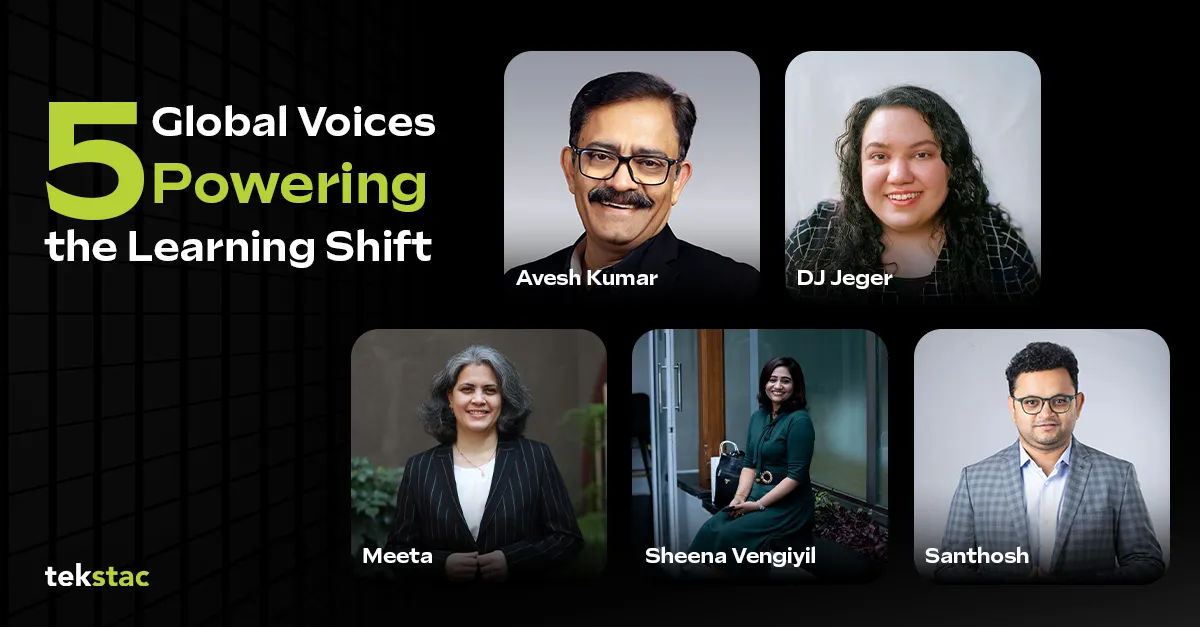
This is pull learning when employees actively seek out knowledge and skills because they see immediate value.
Avesh explains that employees want learning that speaks directly to their current roles, future ambitions, and personal interests. They prefer formats they can consume in short bursts, bite-sized videos, quick simulations, or peer discussion threads.
Sheena’s research shows that microlearning often outperforms traditional training in both engagement and retention. And when it’s integrated into the tools people already use, like Microsoft Teams or Slack, it becomes part of the workday rather than an interruption.
Social learning, too, is gaining ground. Peer-led communities and collaborative forums don’t just distribute knowledge; they strengthen culture and boost application. In fact, Sheena cites data showing that social learning can improve on-the-job application by up to 75%*.
The question for leaders, Santhosh says, must evolve from “How do we make them complete this course?” to “How do we make them want to?”
*According to the 2023 Brandon Hall Group Study.
The Irreplaceable Human Core in a Digital Age
For all the excitement around AI and automation, the human element remains the anchor of impactful learning.
Santhosh reminds us: no algorithm can replace the spark of a great mentor, the resonance of a compelling story, or the thrill of discovery.
Sheena points to psychological safety as a crucial driver of deeper learning. When people feel safe to ask questions, challenge ideas, and admit mistakes without fear of judgment, they engage more fully and innovate more freely.
Avesh adds a deceptively simple truth: learning sticks when it’s fun. Whether through gamified simulations, creative challenges, or interactive storytelling, enjoyment deepens retention.
DJ Jaeger notes that coaching, once reserved for executives, is now being democratized. Everyone, from entry-level employees to mid-career professionals, can benefit from personalized guidance. This doesn’t just accelerate skill development; it reinforces a continuous learning culture where growth is accessible to all.
The Road Ahead: Driving Business Growth Through L&D Transformation
The path forward demands courage, experimentation, and a willingness to lead from the front.
DJ Jaeger cautions leaders against a “wait and see” stance on innovation, especially with AI. The bigger risk, he argues, is being left behind. Early adopters have the advantage of shaping the tools to fit their culture and needs.
Meeta warns against common pitfalls: making decisions driven purely by short-term cost savings, underestimating the importance of sustained sponsorship, and neglecting the creation of internal champions who can carry momentum forward.
In the end, L&D transformation won’t just imply the number of training courses. As DJ Jaeger puts it: “Your legacy isn’t the content you create; it’s the capability you build.”
That’s the real measure of success in the new era of learning: whether your people are more adaptable, more confident, and more capable of taking on tomorrow’s challenges than they were yesterday.
The Learning Shift: What It Means for Your Business
The learning shift is not a memo you send out. It’s a cultural rewire. It’s the difference between a workforce that survives change and one that drives it. And it starts with leaders willing to see L&D not as a cost center, but as the architect of the future.
Tekstac empowers L&D professionals with a 360 degree end to end skilling platform to stay current with rapidly changing technologies. See our mission in action.
This article brings together insights from industry leaders who are shaping the future of learning and development. Below are the voices behind these perspectives—leaders whose experiences across global organizations, startups, and academia offer a rich view of how capability-building is evolving in the GenAI era.
Avesh Jha is Senior Vice President of Global Organizational Development & Performance Management at Hinduja Global Solutions. With 30+ years of global experience, he specializes in leadership development, performance management, and guiding large-scale business transformations.
Sheena Vengiyil is Learning Lead for the India GCC Business at Maximus and a 2024 HR 40 Under 40 honoree. She brings 16 years of expertise in designing impactful learning strategies across global organizations.
DJ Jaeger is Senior Training Manager for Customer Learning and M&A at Akamai Technologies and an adjunct instructor at Portland State University. She focuses on enterprise learning systems, upskilling programs, and inclusive workplace practices.
Meeta Kanhere is Co-Founder of Meraki Leadership Solutions and a seasoned consultant in leadership and organizational development. She works with organizations to build high-performance teams and value-driven cultures.
Santosh Akella is Assistant Manager – L&D at Cognitus and a former president of the Hyderabad Chapter of the Professional Speakers Association India. He is known for creating coaching cultures and designing learning programs that align with business goals.

